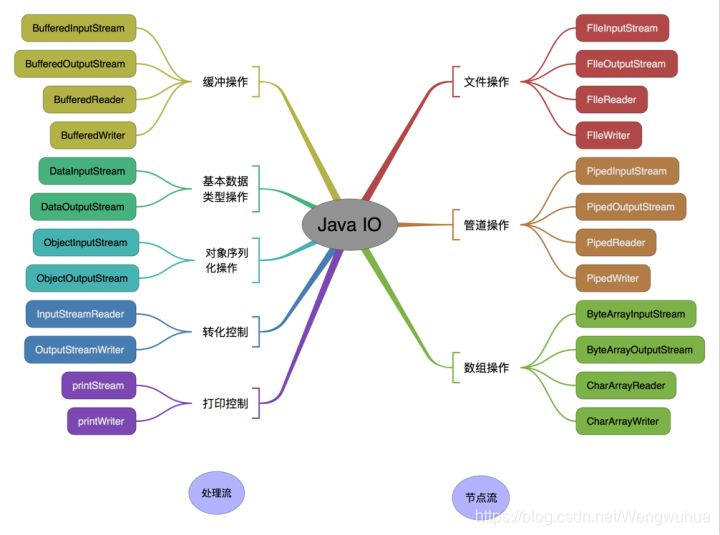版权声明:本文为博主原创文章,未经博主允许不得转载。 https://blog.csdn.net/Wengwuhua/article/details/84450857
IO流
- IO流分类
- 按数据流向分:输入流、输出流
- 按数据类型分:字节流(x xInputStream 读,xxOutputStream写)、字符流(xxRead读,xxWrite写)
如果数据所在的文件通过windows自带的记事本打开并能读懂里面的内容,就用字符流。其他用字节流。
文件操作
- File类的概述和方法介绍
- File类的概述
文件和目录路径名的抽象表示形式 - 构造方法
File(String pathname): 根据一个路径得到File对象
File(String parent, String child): 根据一个目录和一个子文件/目录得到File对象
File(File parent, String child): 根据一个父File对象和一个子文件/目录得到File对象 - 创建功能
public boolean createNewFile(): 创建文件 如果存在这样的文件,就不创建了
public boolean mkdir(): 创建文件夹 如果存在这样的文件夹,就不创建了
public boolean mkdirs(): 创建文件夹,如果父文件夹不存在,会帮你创建出来
注意事项:如果你创建文件或者文件夹忘了写盘符路径,那么,默认在项目路径下。 - 删除功能
public boolean delete(): 删除文件或者文件夹
注意事项:Java中的删除不走回收站。要删除一个文件夹,请注意该文件夹内不能包含文件或者文件夹 - 重命名功能
public boolean renameTo(File dest): 把文件重命名为指定的文件路径
注意事项:如果路径名相同,就是改名。如果路径名不同,就是改名并剪切。 - 判断功能
public boolean isDirectory(): 判断是否是目录
public boolean isFile(): 判断是否是文件
public boolean exists(): 判断是否存在
public boolean canRead(): 判断是否可读
public boolean canWrite(): 判断是否可写
public boolean isHidden(): 判断是否隐藏 - 获取功能
public String getAbsolutePath(): 获取绝对路径
public String getPath(): 获取相对路径
public String getName(): 获取名称
public long length(): 获取长度。字节数
public long lastModified(): 获取最后一次的修改时间,毫秒值
public String[] list(): 获取指定目录下的所有文件或者文件夹的名称数组
public File[] listFiles(): 获取指定目录下的所有文件或者文件夹的File数组
IO流读写文件
字节流读写文件
- 普通输入输出字节流读写
- FileOutputStream三个write()方法
public void write(int b):写一个字节。
public void write(byte[] b):写一个字节数组。
public void write(byte[] b,int off,int len):写一个字节数组的一部分。 - FileInputStream两种读取方式
int read(): 一次读取一个字节。
int read(bytes[] b) : 一次读取一个字节数组。 - 使用示例(复制文件)
字节流一次读一个字节
private static void copyFile_1() throws IOException {
// 复制文件使用的时间是:89352毫秒
// 创建对象
FileInputStream fis = new FileInputStream("C:\\waiting for you.mp3") ;
FileOutputStream fos = new FileOutputStream("D:\\waiting for you.mp3") ;
// 一次读取一个字节
int by = 0 ;
while((by = fis.read()) != -1){
fos.write(by) ;
}
// 释放资源
fos.close() ;
fis.close() ;
}
一次读一个字节数组
private static void copyFile_2() throws IOException {
// 复制文件使用的时间是:154毫秒
// 创建对象
FileInputStream fis = new FileInputStream("C:\\waiting for you.mp3") ;
FileOutputStream fos = new FileOutputStream("D:\\waiting for you.mp3") ;
// 一次读取一个字节数组
byte[] bytes = new byte[1024] ;
int len = 0 ;
while((len = fis.read(bytes)) != -1){
fos.write(bytes, 0, len) ;
}
// 释放资源
fos.close() ;
fis.close() ;
}
- 缓冲输入输出字节流读写
- 相同方式使用缓冲流读写效率较高,常用的文件读写操作使用这种方式。(一次读取一个字节数组的效率远高于一次读一个字节)
- BufferedInputStream读取数据,BufferedOutputStream写出数据
- 使用示例
一次读取一个字节
public static void copyFile_3() throws IOException {
// 复制文件使用的时间是:920毫秒
// 创建高效流对象
BufferedInputStream bis = new BufferedInputStream(new FileInputStream("C:\\waiting for you.mp3")) ;
BufferedOutputStream bos = new BufferedOutputStream(new FileOutputStream("D:\\waiting for you.mp3")) ;
// 一次读取一个字节
int by = 0 ;
while((by = bis.read()) != -1){
bos.write(by) ;
}
// 释放资源
bos.close() ;
bis.close() ;
}
一次读取一个字节数组
public static void copyFile_4() throws IOException {
// 复制文件使用的时间是:53毫秒
// 创建高效流对象
BufferedInputStream bis = new BufferedInputStream(new FileInputStream("C:\\waiting for you.mp3")) ;
BufferedOutputStream bos = new BufferedOutputStream(new FileOutputStream("D:\\waiting for you.mp3")) ;
// 一次读取一个字节数组
byte[] bytes = new byte[1024] ;
int len = 0 ;
while((len = bis.read(bytes)) != -1){
bos.write(bytes, 0, len) ;
}
// 释放资源
bos.close() ;
bis.close() ;
}
字符流读写文件
- 字符流出现的原因:
由于字节流操作中文不是特别方便,所以,java就提供了字符流。
字符流: 字符流 = 字节流 + 编码表。 - 转换流(OutputStreamWriter、InputStreamReader)
public static void main(String[] args) throws IOException {
// 创建转换输入流对象
InputStreamReader isr = new InputStreamReader(new FileInputStream("OutputStreamWriterDemo.java")) ;
// 创建转换输出流对象
OutputStreamWriter osw = new OutputStreamWriter(new FileOutputStream("copyFile.java")) ;
// 复制文件
// 一次读取一个字符复制
// int ch = 0 ;
// while((ch = isr.read()) != -1){
// osw.write(ch) ;
// }
// 一次读取一个字符数组复制文件
char[] chs = new char[1024] ;
int len = 0 ;
while((len = isr.read(chs)) != -1){
osw.write(chs, 0, len) ;
}
// 释放资源
osw.close() ;
isr.close() ;
}
- 高效流(FileWriter,FileReader)
public static void main(String[] args) throws IOException {
// 创建高效的字符输入流对象
BufferedReader br = new BufferedReader(new FileReader("OutputStreamWriterDemo.java")) ;
// 创建高效的字符输出流对象
BufferedWriter bw = new BufferedWriter(new FileWriter("copyFile3.java")) ;
// 一次读取一个字符数组复制文件
char[] chs = new char[1024] ;
int len = 0;
while((len = br.read(chs)) != -1){
bw.write(chs, 0, len) ;
}
// 释放资源
bw.close() ;
br.close() ;
}
- 缓冲流(BufferedWriter ,BufferedReader)
public static void main(String[] args) throws IOException {
/**
* 需求: 使用高效的字符流中特有的功能复制文本文件
*/
// 创建高效的字符输入流对象
BufferedReader br = new BufferedReader(new FileReader("OutputStreamWriterDemo.java")) ;
// 高效的字符输出流对象
BufferedWriter bw = new BufferedWriter(new FileWriter("copyFile4.java")) ;
// 复制文件
// 一次读取一行复制文件
String line = null ;
while((line = br.readLine()) != null) {
bw.write(line) ;
bw.newLine() ;
bw.flush() ;
}
// 释放资源
bw.close() ;
br.close() ;
}
- 复制文件工具类
public class IOUtils {
public static void copyFolder(String srcPahtName , String destPathName , FilenameFilter filenameFilter) throws IOException {
File srcFolder = new File(srcPahtName) ;
File destFolder = new File(destPathName) ;
if(!destFolder.exists()) {
destFolder.mkdir() ;
}
copyFolder(srcFolder , destFolder , filenameFilter) ;
}
public static void copyFolder(File srcFolder , File destFolder , FilenameFilter filenameFilter) throws IOException {
File[] files = null ;
if(filenameFilter == null) {
files = srcFolder.listFiles() ;
}else {
files = srcFolder.listFiles(filenameFilter) ;
}
// 遍历
for(File f : files) {
// 创建目标文件
String destFileName = f.getName() ;
File destFile = new File(destFolder , destFileName) ;
// 复制文件
copyFile(f , destFile) ;
}
}
public static void copyFile(File srcFile , File destFile) throws IOException {
// 创建流对象
BufferedInputStream bis = new BufferedInputStream(new FileInputStream(srcFile)) ;
BufferedOutputStream bos = new BufferedOutputStream(new FileOutputStream(destFile)) ;
// 一次读取一个字节数组复制文件
byte[] bytes = new byte[1024] ;
int len = 0 ;
while((len = bis.read(bytes)) != -1){
bos.write(bytes, 0, len) ;
}
// 释放资源
bos.close() ;
bis.close() ;
}
}
IO流分类
- 按操作方式分类结构图

2. 按操作对象分类结构图

参考文章:https://github.com/yangchong211/YCBlogs/blob/master/java/IO流知识